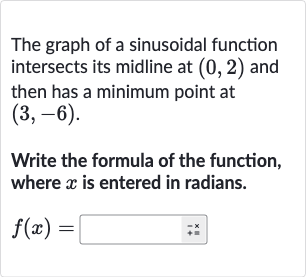Full solution
Q. The graph of a sinusoidal function intersects its midline at and then has a minimum point at .Write the formula of the function, where is entered in radians.
- Identify Amplitude, Midline, and Phase Shift: Identify the amplitude, midline, and phase shift of the sinusoidal function.The midline of the function is the horizontal line that the function oscillates around. Given the point , we know that the midline is . The minimum point of the function is . Since the midline is and the minimum value is , the amplitude of the function is the distance from the midline to the minimum, which is . The function has a minimum at , which means the phase shift is units to the right.
- Determine Period: Determine the period of the sinusoidal function.Since no information about the period is given, we assume the function has the same period as the basic sine function, which is . Therefore, the period of the function is .
- Write General Form: Write the general form of the sinusoidal function.The general form of a sinusoidal function is , where is the amplitude, is related to the period by the formula , is the phase shift, and is the vertical shift (midline). We have already determined that , (since the period is ), , and .
- Substitute Known Values: Substitute the known values into the general form of the sinusoidal function.Using the values , , , and , we substitute into the general form to get . However, since the function has a minimum at , we need to use the cosine function, which starts at a maximum, and include a negative sign to reflect the graph vertically. This gives us .
More problems from Write a quadratic function from its x-intercepts and another point
QuestionGet tutor help
QuestionGet tutor help
QuestionGet tutor help
QuestionGet tutor help
QuestionGet tutor help
QuestionGet tutor help
QuestionGet tutor help
QuestionGet tutor help

